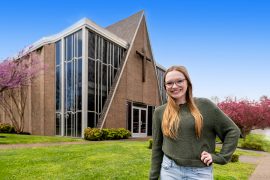With its new business building, Marshall aims to change the game for the university and the surrounding business community.
By Jean Hardiman
MU Summer 2024
The moment you set foot in the Brad D. Smith Center for Business and Innovation, you get the idea that business students at Marshall University are getting a next-level education.
You see the digital sign with current stock information gliding past. You see the bright, modern atrium where students take a minute to catch up with each other, and the iCenter where they’re honing the skills of design thinking.
Stepping inside the Encova Auditorium has the feel of walking into a movie theater, only with educational technology that is second to none. And take a few minutes to walk around the building, and you’ll see a sleek, modern computer lab, conference rooms and nine classrooms equipped with ThinkHub Education technology that includes an instructor station and student stations that can work both collaboratively and independently.
The facility also has a finance lab that will house 12 Bloomberg terminals with all the detailed information students could want regarding wealth management — and there are plans to host a student investment fund to help them get hands-on investment training.
Simply put, the building changes the game.
“I know that I feel more excited and empowered to attend classes, collaborate and learn with the new, state-of-the-art technology in the classrooms,” said Zachary Kincaid, a graduate assistant in the Lewis College of Business who is working toward his MBA. “The new technology allows the professors to better communicate and visualize the information at hand to students.”

It’s the result of contributions from multiple generous donors, including its namesake, Marshall President Brad D. Smith, and his wife, Alys Smith. Brad D. Smith is a 1986 graduate of Marshall’s College of Business and a former CEO and executive chairman of Intuit who has invested greatly in bettering his home state.
This spring, he described the building’s dedication as a “milestone moment in a series of milestone moments that are happening on our campus, in our city, across the state and honestly in the Appalachian region. It’s because it is our time. We are seeking this opportunity and we are leaning in. It is the power of we.”
“The Smiths’ generous transformational gift of $25 million laid the foundation for the project, demonstrating their unwavering commitment to Marshall University’s success,” said Provost and Senior Vice President for Academic Affairs Avinandan “Avi” Mukherjee, who was dean of the Lewis College of Business at the time. “Additionally, support from other donors, faculty, administrators and community members propelled the vision forward. Strategic planning, meticulous execution and the dedication of all involved were instrumental.”
Their support made — and continues to make — the Brad D. Smith Center for Business and Innovation the forward-focused educational facility that it is.
But becoming forward-focused doesn’t happen automatically. Training the business faculty to use the building’s new technology was an undertaking that began in 2023, said Eric Himes, director of academic technology experiences at Marshall. It started with a demonstration early in the year, followed by hands-on training sessions that began in September, and faculty were largely very receptive to learning entirely new teaching techniques, he said.
“It’s flexible enough to let them teach any way they want to,” Himes said. “There are some active learning classrooms for group work. … It’s also focused on hybrid and hi-flex situations so you can attend face-to-face or attend virtually.”

Whether students attend in person, attend online during the allotted class time frame or attend virtually at their convenience, there is technology in the building with flexibility to attract all kinds of students, he said.
“It’s the same learning outcomes, but it may be a different assignment that you can complete within a certain time,” he explained.
Susan Lanham, an associate professor in the college’s Department of Accountancy & Legal Environment, is a fan of the new technology, which includes T1V collaborative software, auto-tracking camera systems, digital whiteboards, and numerous LCD monitors, “making it more interactive and relevant to the modern workplace,” she said.
Whether in the classroom or joining virtually via Microsoft Teams, students can work together seamlessly, Lanham said.
“This setup is very similar to the collaborative nature of today’s work environments, which will better prepare our students for the realities of their future careers,” she said.
Being able to see the professor’s screen and share your own screen with the group is “really good for collaboration and projects,” said Elli Barry, a junior marketing and management major, adding that walking into the new building is like walking into a whole new environment. “I feel like we’re in a place that’s really advanced,” Barry said.
It’s been truly incredible witnessing the transformation in how faculty teach, and how students learn, Lanham said.
“These technologies are not just gadgets,” Lanham said. “They provide new opportunities for learning. Students are more engaged as they interact with content in ways that were unimaginable a generation ago.”
Lanham was curious about how things would go when students in her Forensic and Investigative Accounting class had their first group presentations.

“It turned out they didn’t need any instructions from me at all. They had absorbed everything they needed by watching me use the technology in previous lessons,” she said. “They were thrilled to be able to send some of their content to the six active learning stations scattered around the room, while other pieces were displayed on the four wall-mounted LCD monitors.
“With a total of 10 viewing monitors at their disposal, the possibilities for how they could present their information were virtually limitless. It was a clear moment of realization for me, seeing firsthand how intuitive and engaging this technology could be for students, and how it allowed them to present their work in such a dynamic and interactive way.”
The good news for the business community is that not only will Marshall be preparing graduates who are comfortable with the latest tools, but community businesses will also have the knowledge and research that is produced at the university and be able to utilize the facility, particularly those who stay actively involved with the Lewis College of Business.
Even in its first semester, “the new building has become a hub for seminars, speaker series, conferences and other business-related events that students are able to attend,” Kincaid said. “Our new building is a forum to exchange ideas and discuss new advancements across business fields. I think that our building has become an attraction for experienced alumni, professionals and other educators to come and share their work and experiences.”
The center serves as a bridge between academia and industry, Mukherjee said.

“It offers a platform for innovative projects, entrepreneurial ventures and economic development initiatives,” he said. “Its strategic location within Huntington’s downtown not only enhances the university’s presence but also reflects Marshall’s commitment to community engagement and revitalization. By leveraging this intersection between education and economic development, the center becomes more than just a building. It becomes a catalyst for positive change and growth within both the university and the broader cityscape of Huntington.”
And it’s just the beginning of development along Fourth Avenue, with mixed-use properties envisioned in a continued partnership between Marshall and the entities that collaborated on the business building — the development company Fairmount Properties, PJ Dick Construction and the architectural firm Perkins Eastman. Next up: Marshall’s new Institute for Cyber Security building that is planned on the corner of Fourth Avenue and Hal Greer Boulevard.
“It’s an exciting time here at Marshall,” Lanham said. “Our current leadership team is transforming our university into something truly incredible for our students, and I’m eternally grateful to be a part of it.”
How to help
• Donations to the Brad D. Smith Center for Business and Innovation Building Fund (BDSCBI Building Fund) ensure its sustainability and enable ongoing enhancements to both facilities and programs. Contributions can fuel initiatives and maintain cutting-edge resources, Provost Mukherjee said.
• Mentorship programs provide opportunities for alumni and professionals to share expertise and industry insights, guiding students on their career paths.
• Volunteering opportunities allow active engagement with students, fostering their professional development and contributing to the community’s prosperity.
https://give.marshall.edu/project/26398/donate?des_id=633201
It’s an exciting time here at Marshall. Our current leadership team is transforming our university into something truly incredible for our students, and I’m eternally grateful to be a part of it. — Susan Lanham, Associate Professor, Department of Accountancy & Legal Environment
I know that I feel more excited and empowered to attend classes, collaborate and learn with the new, state-of-the-art technology in the classrooms. The new technology allows the professors to better communicate and visualize the information at hand to students. — Zachary Kincaid, MBA student, Lewis College of Business





